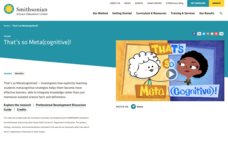Bozeman Science
ESS2C - The Role of Water in Earth's Surface Processes
Water is something most of us take for granted. Explore the important aspects of water with a short video lesson. The instructor addresses the key instructional points of the NGSS standard ESS2C. He explains the complexity of the water...
Bozeman Science
ESS2D - Weather and Climate
Where does our weather come from? A thorough video lesson discusses the NGSS standard ESS2D instruction from elementary through high school. The instructor explains the factors the impact weather and climate and the long-term effects of...
Bozeman Science
ESS3C - Human Impacts on Earth Systems
The human impact on the earth's systems often has unintended consequences. A comprehensive video lesson builds a progression for teaching the standards ESS3C in elementary through secondary classrooms. Instruction focuses on the human...
PBS
Real-Life Math | Zoo Keeper, Hoofstock
Zoos are a great place to learn about math (and see cute animals, too). Part of a larger Real-Life Math series, an informative video, which has a zookeeper describe math in her job, sets the stage for the lesson. Learners answer...
Poetry4kids
How to Rhyme – a Video Poetry Writing Lesson
A host details what does and does not rhyme in an informative video that focuses on creating words for a poem. He provides examples and discusses how rhyming makes a difference in tone and purpose.
Smithsonian Institution
That’s so Meta(cognitive)!
Explicitly teaching metacognition strategies to pupils sometimes affects their learning potential. A PD video lesson from the Good Thinking series explores the concept and offers strategies for teachers to incorporate in their...
Smithsonian Institution
Science: A Work in Progress
Science is best taught by connecting concepts rather than isolating topics. Using classroom examples, a video lesson highlights the importance of showing the interconnection of science concepts. The instruction includes strategies to...
Curated OER
First Grade Math Lessons : Two Digit Addition for First Grade Math
Homeschoolers stop here! Made just for tutors and homeschoolers, this video explains the best method for teaching first graders to add double digit numbers. Note: There are other ways to teach this concept, this one is basic and easy to...
Curated OER
First Grade Math Lessons: First Grade Math Addition Tables
How do we, as educators, build a solid mathematical foundation for young learners? This video suggests using flashcards, memorization, and addition tables. How to use flashcards, tips, and things not to do are all covered.
Rockin' English Lessons
"A and An Song"–English Lesson for "A and An"–Rockin' English
The catchy beat and informative lyrics of this video support grammar instruction of indefinite articles a and an. As the song plays in the background, sentences and charts showcased when to use a or an with vowels or consonants.
Teaching Channel
New Teacher Survival Guide: ADHD in the Classroom
Discover one teacher's efforts to improve in-class transitions and help students to remain engaged and on-point during class. You'll begin by viewing a sample lesson in a special education classroom with follow-up commentary and...
TED-Ed
Why Are Blue Whales So Enormous?
Isn't it strange that Earth's largest animal lives on one of its tiniest? Using Sesame-Street-style puppetry, this video explains how this phenomenon happens. Viewers learn that a single mouthful of krill taken in by a whale has the...
Curated OER
Singapore Math: Grade 3a, Unit 1 (part 9)
Have your class work through a series of exercises focused on number patterns with place value. Present each problem, allow your class to work through each one, and then show them what Sal did to solve each problem. Every problem is...
Curated OER
STEMbite: Engaging Plants
The science teacher discusses features of weeds in his backyard and how their thorns are used by the plant to engage animals. Other methods that plants use to engage animals include appearance, scent, and the taste of their products. Mr....
Scholastic
Study Jams! Fractions
What can quesadillas teach your class about fractions? More than you might think. AJ and Zoe from the StudyJams! crew use this Mexican cuisine to explain how fractions are just equal parts of a whole, defining the key terms numerator and...
Scholastic
Study Jams! Circle Graph
Over a pizza dinner, RJ and Mia discuss how to use a circle or pie graph to represent data. After viewing, data analysts can use a Test Yourself feature to assess their own understanding. This is ideal for use in a flipped classroom lesson.
Lesson Planet
EdTech Tuesdays: Classroom Video Games with Mat Frenz
Curious about ways to use students' interest in video games to enhance their learning? Listen as Mat Frenz from GlassLab Games discusses the similarities between video game design and lesson design, and how educators and developers are...
Lesson Planet
EdTech Tuesdays: Bing in the Classroom
More than a search engine, Bing in the Classroom, also known as Bing for Education, is a teaching tool, providing lesson plans, professional development, and community discussions. The narrators model how to access the various features...
Crash Course Kids
Wood, Water, and Properties
Why do bricks make terrible windows? Learn about how the different properties of matter, including transparency, reflectivity, and freezing, boiling, and melting points can help you observe what they are, as well as indicate their...
True Food TV
How Does it Grow? Pumpkins
Did you know pumpkins are a fruit? Discover how different varieties of pumpkins are grown for different purposes in a brief informational video.
PBS
St. Patrick's Day | All About the Holidays
Éire go Brách! Join in the festivities of St. Patrick's Day with a fun and informative video from a series on world holidays.
PBS
Independence Day | All About the Holidays
How do your students celebrate Independence Day? Watch a short video about how the Founding Fathers designated the Fourth of July as an annual way to commemorate their newfound freedom.
PBS
Cesar Chavez Labor Leader and Civil Rights Activist Video
Long hours, no restrooms, and low pay were all part of the life of migrant farm workers before the work of union leader Cesar Chavez. The video describes the life of Chavez and his family working in the fields of California. It also...
Educreations
Dividing Using Friendly Numbers
Simplify division for young mathematicians by teaching them how to use friendly numbers when finding quotients. Three examples are presented in this instructional video that models the process of breaking large dividends into sums of...
Other popular searches
- Esl Lessons
- Elementary Lessons
- Math Lessons
- Art Lessons
- Money Lessons
- Preschool Lessons
- 2nd Grade Lessons
- Art Lessons Primary
- Esl Lessons Grammar
- High School Lessons
- 3rd Grade Lessons
- Middle School Lessons

























